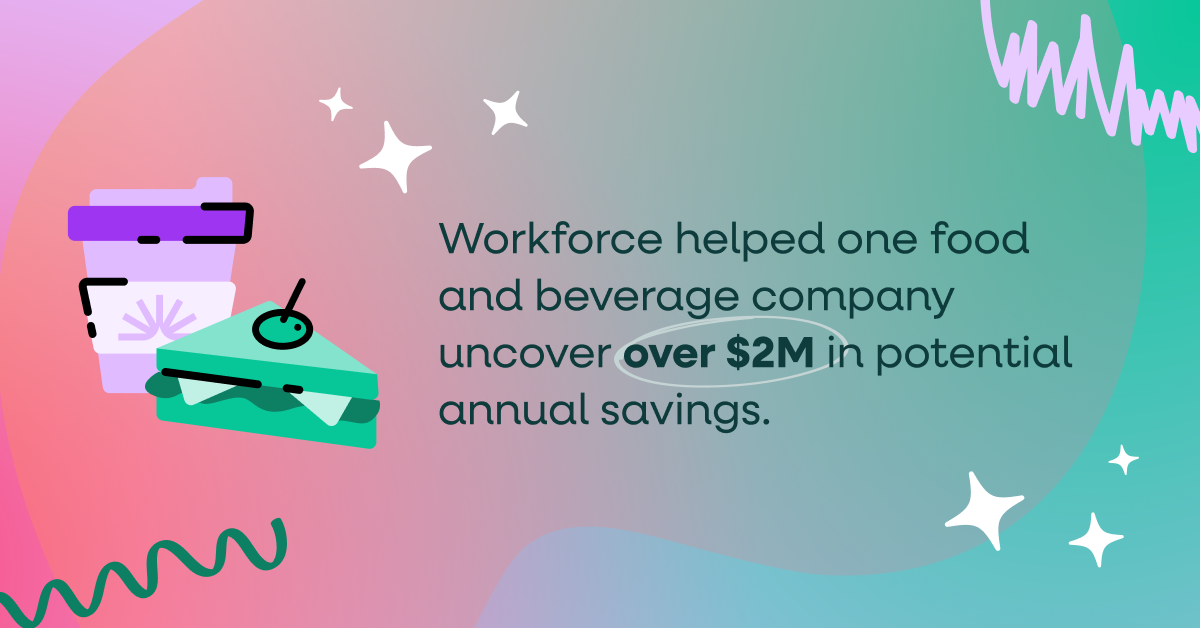Software subscriptions could be silently torching your budget. From overlooked auto-renewals to tools no one uses, SaaS waste creeps in quietly and adds up fast. Controlling spend, reducing risk, and reinvesting in the tools that your team relies on requires more than log-in metrics and gut instinct.
Key takeaways
A trillion-dollar market, 30% wasted. Global SaaS spend is projected to hit US $1.13 trillion by 2032, yet about one-third vanishes into unused seats, duplicate tools, and auto-renewals [Gartner].
Used ≠ useful. Logins show if people open a tool; behavioral data shows if it actually drives outcomes.
Stop wasting millions on shelfware. Fullstory Workforce helped an enterprise food and beverage company uncover over $2 million in potential yearly savings.
Governance boosts product velocity. Lean stacks cut duplicate analytics, align teams, and speed release, so the win isn’t just financial.
What is SaaS spend management?
SaaS spend management is the process of tracking, optimizing, and controlling an organization's spending on software subscriptions. It helps companies maximize value from their software investments while reducing unnecessary costs through:
Spotting redundant or underused SaaS applications
Tracking usage, costs, and SaaS contracts in one dashboard
Connecting software spend to measurable business outcomes
Giving product, IT, and finance a shared, data-driven view
The silent budget leak in your SaaS stack
It’s all too easy to invest in software solutions and then forget about those investments entirely. Trials linger, premium tiers sit idle, and renewal emails vanish. Multiplied across departments, that sprawl torches cash.
Five culprits behind runaway costs
Inefficient workflows
Why it’s expensive: Teams adopt multiple tools to work around problems, driving up costs
Quick fix: Map cross-app journeys to optimize tool usage and spend
Support bottlenecks
Why it’s expensive: IT time wasted on issues they can't quickly diagnose
Quick fix: Give IT a view into what the employee saw or clicked before submitting a ticket, so they can troubleshoot faster
Underutilized licenses
Why it’s expensive: Paying for seats that aren’t being used
Quick fix: Review usage patterns to see which licenses are underused, and reassign or remove them
Shadow IT
Why it’s expensive: Unauthorized tool purchases to bypass friction points
Quick fix: Track all tools in use so you can reduce duplicate spend and flag unsanctioned apps before they create risk
Low-adoption tools
Why it’s expensive: Apps that cost money but don't improve productivity
Quick fix: Look at if, how, and how often a tool is used before deciding to renew, expand, or cut it
Why SaaS spend management matters to product and digital teams
Optimizing SaaS spend helps product and digital teams ensure their tools are actually used in workflows and actively improve the digital employee experience. Without visibility into tool usage and ownership, teams often struggle with overlapping software, unclear accountability, and hidden workflow inefficiencies. These issues not only waste budget but also slow down collaboration and delivery.
By understanding how tools are used across the stack, teams can simplify workflows, reduce distractions, and ensure budgets are aligned with business priorities. This knowledge also helps them prepare for conversations with finance by providing real data on what tools are essential, which ones can be scaled back, and where reinvestment could deliver greater impact.
What an optimized SaaS stack looks like
Millions recaptured: Using food and beverage analytics, one enterprise uncovered $2M+ in potential annual savings by reallocating or eliminating underused licenses.
Shadow IT minimized: A single source of truth reduces risk from unsanctioned tools.
Seamless workflows: Consolidated tools mean faster cross-team handoffs and less context switching.
No budget surprises: A centralized renewal calendar brings clarity to forecasting and spend.

Four-step SaaS spend optimization playbook
Between departmental purchases, personal card swipes, and forgotten trials, software spending has a way of growing in the shadows. A systematic approach to spend optimization can help reclaim that lost budget.
Here's how to start:
1. Discover everything
You can’t optimize what you can’t see. Start by building a complete inventory of every SaaS tool in use—not just what finance or IT has approved.
Pull spend data from:
credit card statements
expense reports
procurement systems
Check authentication sources like single sign-on and directory tools. This is where shadow IT often shows up: tools purchased by individual teams, paid for with corporate or personal cards, and completely off IT’s radar.
2. Rightsize licenses
Once you know what tools your teams use, zoom in on how (and if) users are interacting with them. Define what constitutes “inactive” usage—for example, no login in 30 days—and track how many licenses fall outside that threshold.
Additionally, keep an eye out for licenses still assigned to former employees or premium tiers that aren’t delivering premium value. Downgrading or reclaiming underutilized licenses can produce immediate cost savings, often without impacting productivity in the slightest.
3. Consolidate and negotiate
Over time, it’s common for multiple teams to adopt their own tools for the same jobs. An application rationalization pass surfaces those overlaps, so you can standardize on best-fit tools, cut spend, and walk into renewals with data. While those decisions may have made sense in isolation, they often result in duplicated spend, fragmented workflows, and steeper IT overhead. Group your tools into functional categories, then compare what’s actually being used and valued. Standardize on best-fit tools for each purpose, and bring usage data to the table when it’s time to renew. Vendors are more likely to be flexible when you show them you’ve done your homework.
4. Govern and monitor
Finally, make SaaS management an ongoing practice, not just a fire drill when budgets tighten. Create a cross-functional working group that includes stakeholders from IT, Finance, and Product. Meet regularly (quarterly is a good starting point) to review renewals, usage trends, support tickets, and tool performance. Keep contracts and license data in a centralized dashboard. Set clear criteria for evaluating new tool requests and establish KPIs for app adoption and ROI.
Sound complex? Let behavioral data do the heavy lifting
Reducing SaaS spend manually is possible, but it’s time-consuming and often built on incomplete data. For example, license counts might show who logged in or how often, but they don’t reveal how tools are used in real workflows.
Workforce integrates behavioral data with your existing IT and SaaS management tools to provide a deeper lens into how employees engage with their software.
Surface hidden waste: Workforce automatically uncovers apps sitting idle, barely used, or used in inefficient, fragmented ways.
Spot workflow friction: Identify where tools interrupt rather than enable, from confusing UI flows to redundant steps that drag down productivity.
Act with clarity: With real behavioral signals, IT, finance, and product teams gain shared context to inform renewals, rightsizing, change management, and support.
This allows you to empower people to work smarter with the tools they already have.
Spend smarter with Workforce
If you manage spending with a spreadsheet and assumptions, it’s easy to lose track of where the money goes. Subscriptions renew without review, seats stay assigned to people who don’t use them, and new tools are added without anyone checking what’s already in place.
Getting that under control doesn’t have to be complicated. With behavioral data that shows not just what’s in your stack but how it’s being used, it’s easy to spot waste, reduce overlap, and make better decisions about where to reinvest.
Workforce helps teams do exactly that. It autocaptures cross-app journeys, flags shadow IT, and scores adoption—no tags, no scripts. If you’re ready to clean up your stack and cut spend, see what Workforce can show you.
Your software budget deserves better data. See Workforce in action →




